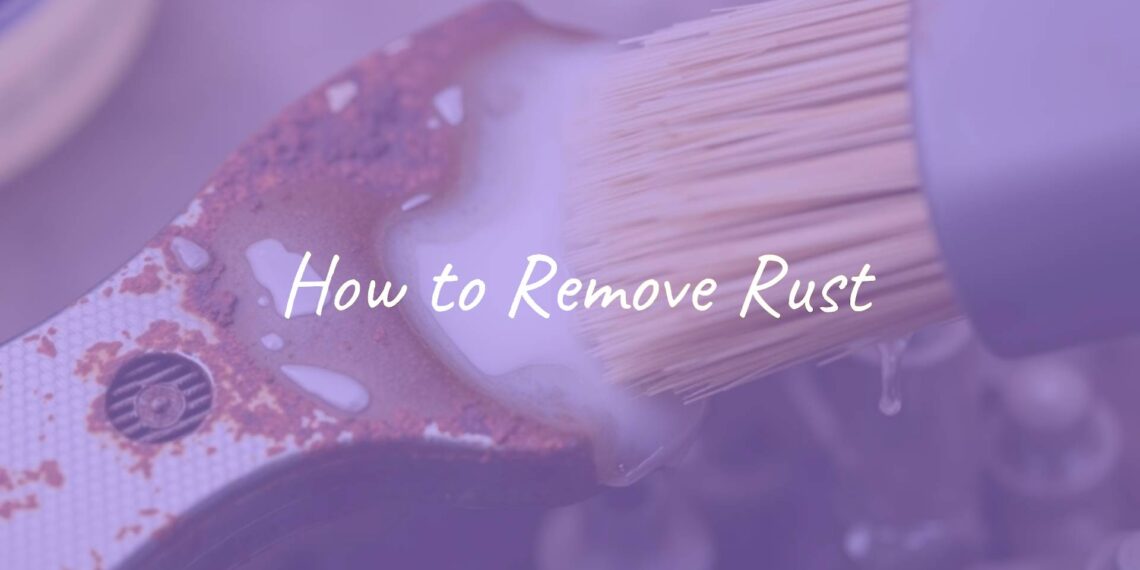Rust, the reddish-brown coating on metal, can ruin tools, weaken parts, and spoil the look of favorite items. The good news: you can remove it. With a few simple methods and some scrubbing, many rusty things can be cleaned and used again. This guide covers options from easy kitchen tricks to strong store-bought products, so you can pick a method that fits your task.
Rust (corrosion) starts when water and oxygen react with iron. Humidity and temperature speed this up. Over time, the metal combines with water and oxygen and breaks down. Iron and steel rust the most, but copper, aluminum, stainless steel, and brass can also corrode. Gold and platinum hardly react at all. Knowing how rust forms helps you stop it and clean it more effectively.

Which Methods Can Remove Rust Effectively?
You can use gentle, natural methods or stronger chemical ones. The right choice depends on how bad the rust is, what metal you have, and whether you prefer household items or specialty products.
Almost every method needs some scrubbing. Use steel wool, a wire brush, sandpaper, or even a potato to help lift rust after it softens.
Should You Use Manual or Chemical Rust Removal?
This is often the first choice to make. Manual methods use abrasion (sanding, wire brushing, steel wool). They work well for light rust, give you control, and avoid harsh chemicals. Chemical removers use acids (like phosphoric or oxalic acid) to dissolve rust. They are fast and good for heavy or hard-to-reach rust but need careful handling, gloves, and good airflow. Avoid strong chemicals on sensitive finishes.
| Method | Best for | Pros | Cons |
|---|---|---|---|
| Manual (sanding/brush) | Light surface rust | No harsh chemicals; precise control | More effort; slow on heavy rust |
| Chemical (acids/liquids) | Stubborn or pitted rust | Fast; reaches tight spots | Safety gear needed; can damage finishes |
What Are Common Home Remedies for Removing Rust?
Before using stronger products, try items you may already have in your kitchen. These are mild on metal and the environment and work well on smaller jobs or lighter rust.
Pick a method and apply it correctly for the best results. Here are popular options and how to use them.
Baking Soda Paste
Baking soda is handy for light rust on thin metal or small stains. It is mildly abrasive and helps lift rust without scratching much.
Rinse the item and shake off water. Sprinkle baking soda on the rust so it’s well coated. Let it sit for about an hour. Scrub with steel wool or a metal brush until the rust lifts. Rinse and dry well to prevent it from coming back.
White Vinegar Soak
White vinegar works well for tools or parts that can be fully soaked. The acetic acid dissolves rust over time.
Put the item in a white vinegar and leave it overnight. Scrub with steel wool or a brush after soaking. If the item is too big to dip, soak rags in vinegar and wrap them around the rusty spots for several hours. Rinse and dry completely when done.
Salt and Lemon Juice
Salt plus lemon juice makes a strong natural cleaner because lemon contains citric acid. This works well on small rust patches, like on knives or decor.
Cover the rust with salt, then squeeze lemon (or lime) juice over it. Let it sit for a few hours. Scrub with the fruit rind. Repeat if needed. Rinse and dry.

Potato and Dish Soap
A potato contains oxalic acid, which helps break down rust. Paired with dish soap, it can be an effective scrubber.
Cut a potato in half and coat the cut side with dish soap. Rub it on the rust like a scouring pad. For tough spots, leave the potato on the area for a few hours, then scrub. This is handy for kitchen items but can be messy, so work over a sink. For knives, push the blade into a potato and leave it for a few hours, then clean.
Citric Acid Solutions
Citric acid is stronger than lemon juice and works well on larger rusty tools.
Mix 2-3 tablespoons of citric acid powder in hot water. Submerge the item overnight. Note: it can strip paint, so only use it on pieces that can be safely soaked. In the morning, scrub off loosened rust, rinse, and dry.
Cola for Rust Removal
Cola contains a little phosphoric acid, the same kind used in many rust removers. It can help with light rust.
Soak the item in cola for several hours or overnight. It will be sticky, so wash it well afterward. Scrub, then rinse and dry.
Which Commercial Products Remove Rust Most Reliably?
If home fixes do not work or the rust is heavy, use products made for rust removal. They are fast and strong.
Choose a product suited to your item and follow the label. Many use strong chemicals and need careful use.
Rust Remover Liquids and Gels
These products use acids (often phosphoric or oxalic) to dissolve rust. They work on many metals and can reach into pits.
Products like Engineer Rust Remover ZC-28 act quickly. Even if a product is milder on skin, wear gloves. Avoid using strong acids on sensitive surfaces. For best results with some liquids, gently warm the solution (do not overheat). Let it sit as directed, scrub off the softened rust, then rinse well.
Rust Converter Treatments
Rust converters change rust into a stable, black coating that stops more corrosion and acts as a base for paint.
Use a converter if you plan to paint tools or metal parts. It turns rust into a paint-ready layer and saves time on heavy grinding. After it cures, add primer and paint to protect the surface.
Powder Cleansers and Abrasives
Some powder cleaners, like Bar Keepers Friend, contain oxalic acid and can clear rust stains without scratching most surfaces.
Wet the area and sprinkle the powder. For tough spots, make a paste with a little water. Let it sit a few minutes, then scrub with a damp cloth or sponge. Rinse well to remove residue.
WD-40 and Lubricant Sprays
WD-40 Multi-Use Product is not an acid remover, but it helps loosen surface rust and frees stuck parts.
Brush off loose rust first. Shake the can and soak the area. Wait 5-10 minutes. Scrub with a wire brush, working from the worst spots to the lighter ones. Wipe clean. A light coat now and then can help prevent rust from coming back.
How to Remove Rust Step by Step on Different Surfaces
The basics are the same, but different items need different steps to avoid damage. Below are common cases and what to do.
Check how deep the rust goes and what the item is made of before you choose a method. A fragile antique needs a gentler approach than a garden shovel.
How to Remove Rust from Metal Tools
Tools meet water and damp air often, so they rust easily. Cleaning them improves both looks and performance.
- Heavy rust: Soak tools in white vinegar overnight, then scrub.
- Light rust: Apply a baking soda paste, wait an hour, then scrub.
- Diesel option: Soak in a can of diesel for a day, then scrub.
Dry fully after any method and apply oil or a rust-inhibiting coating. For firearms, use light oil and a medium-grade steel brush with gentle, repeated passes.
How to Remove Rust from Metal Furniture
Outdoor metal furniture often develops surface rust. Cleaning and protecting it adds years of use and keeps it looking good.
Start by sanding or using a wire brush to remove loose rust and paint. This step is important for prep. Treat remaining rust with a converter to stop it. After it cures, add primer and paint. For small spots, try baking soda paste or lemon with salt, then scrub. Finish with an outdoor-rated paint or clear sealant.

How to Clean Rust from Bike Chains and Parts
Rust on a bike chain hurts performance. Cleaning it can greatly improve your ride.
If you can, remove the chain and soak it in white vinegar overnight. For lighter rust, cola can work, but you will need to wash off the sticky film. After soaking, scrub with a stiff brush or old toothbrush. Rinse, dry fully, and apply a good bike chain lube.
What To Do with Rust on Stainless Steel
Stainless steel can still rust, especially in damp kitchens and bathrooms.
Use mild methods to keep the finish intact. Try a potato half with dish soap as a scrubber. For stubborn spots, use a baking soda and lemon paste or a powder cleaner like Bar Keepers Friend. Always rub with the grain to avoid scratches. Rinse and dry right away.
Safe Rust Removal from Kitchen Appliances
Appliances often have stainless or enamel finishes, so be gentle to avoid damage.
A potato with dish soap works well for small stains. You can also apply a paste of two parts baking soda to one part lemon juice, let it sit for at least 30 minutes, then scrub. On stainless, always clean with the grain. After cleaning, wash with mild soap and water and dry completely.
What Precautions Should Be Taken When Removing Rust?
Safety matters when you use chemicals or abrasive tools. Good prep protects you and helps the job go smoothly.
Know the risks and get ready before you start. Skipping safety steps can lead to injury or damage.
Protective Gear and Safety Tips
When starting a rust removal project, especially with chemicals or sanding, wear the right gear:
- Gloves to protect your hands
- Safety glasses or goggles to protect your eyes
- A dust mask or respirator when sanding
- Long sleeves and pants to protect skin
Read product labels and follow their directions and warnings. Use tools with care and keep your workspace clean.
Proper Ventilation and Disposal of Chemicals
Work in a well-ventilated area, especially with chemical removers that give off fumes. Open windows and use fans, or work outside if possible.
Dispose of chemicals the right way. Do not pour them down the drain unless the label says it is safe (some chelating products are okay). Check local rules for chemical disposal. Throw out used rags and brushes that touched chemicals in a safe way.
Frequently Asked Questions about Rust Removal
Even with a full guide, some common questions come up. Here are quick answers to help you choose the next steps.
These points cover how long results last and when to replace a rusty item instead of cleaning it.
Is Removing Rust Permanent?
No. Rust forms when metal meets oxygen and moisture. You can remove current rust, but the metal can rust again if left unprotected.
Apply a protective layer after cleaning, like paint, a rust-inhibiting primer, oil, or wax. Keep items clean and dry and refresh coatings as needed. Removing rust treats the problem you see; protection keeps it from coming back quickly.
When Should You Replace Rather Than Clean Rusty Items?
This depends on value, how deep the rust is, and whether the metal is still strong. If the rust is only on the surface and the metal is sound, cleaning is often worth it.
If rust has caused deep pits, holes, or thin, weak spots, replacement is usually safer and more practical. For example, do not rely on a weakened, load-bearing frame. Also weigh the time and cost of repair against the item’s value. Put safety and function first if corrosion is severe.













![What to with Scrap Metal? [infographic]?](https://facts-homes.com/wp-content/uploads/2019/07/645413-POPYOV-391-120x86.jpg)





